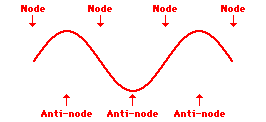As we can recall from the previous lesson, an electron is a negative particle that exists in the orbital of the atom.
Today we learned about a modern theory called 'quantum theory.' In this theory, the electron is a cloud of negative charge, not a particle. Orbitals are areas in 3D space where the electrons most probably are. The area that is most dense is where the probability of finding the electron is the highest. Electron density is the density of this electron cloud. The energy of the electron is in its vibrational modes, like notes on a guitar string. There are also anti-nodes. In the picture below, we see where a node and anti-node are located.
This picture has a mode of three.
Photons are produced when high energy modes change to lower energy modes.
Something important to notice is that despite being in period four, the d-block electrons are numbered 3. This is because the electron configuration moves from lowest energy to highest energy. An excellent picture to represent this:
S-Block:
Each orbital holds two electrons. (This is true of the other blocks as well. Each holds two electrons, and we will discuss this later on.) Hydrogen and helium are in the s-orbital only.
P-Block:
There are three suborbitals. They correspond to Px, Py, and Pz. Each, as mentioned above, contains electrons, together forming a maximum total of six electrons .
D-Block:
There are five suborbitals. Each contain two electrons, up to a maximum of 10 electrons.
F-Block:
There are seven suborbitals. Each contains 2 electrons, up to a maximum of 14 electrons.
When naming the amount and type of electrons in an amount, we use the following pattern:
abc – where a corresponds to the Principle Quantum Number (principal energy levels in an atom are designated by the quantum number); b to the orbital type (s,p,d,f); and c to the number of electrons in the orbital. This notation will tell us the electron configuration of an atom or ion. The added value of the superscripts is equivalent to the number of electrons in an atom.
Well, now that we are equipped with this knowledge, let’s try a question:
How many and what type of electrons are in scandium?
Well, we first identify the number of electrons, which is 21. Now, we start with the first s-block, which can contain two electrons. Then we progress to the second s-block, which can contain two more. Then we arrive at the three p-blocks, and obtain six additional electrons. We keep this up until we reach 21 electrons. The answer is: 1s22s22p63s23p64s23d1.
To check, we add the electrons up for a confirmed total of 21. We can break this down and see how it relates to Bohr’s model. 1s2 2s22p 63s23p6 4s23d1. The red represents the first shell, blue the second; green the third; and black the fourth.
Strontium can also be written as [Ar] 4s23d1. This shorter method utilizes the nearest (and preceding) noble gas and simply adds in the remaining electrons.
Using the knowledge we learned, we know that [Ar], [Cl]-, and [Ca]2+ they all contain the same electron configuration, which is said to be isoelectronic.
Posted By Andrew.



No comments:
Post a Comment